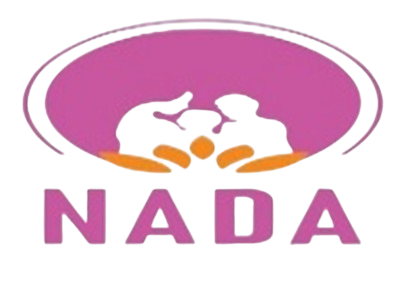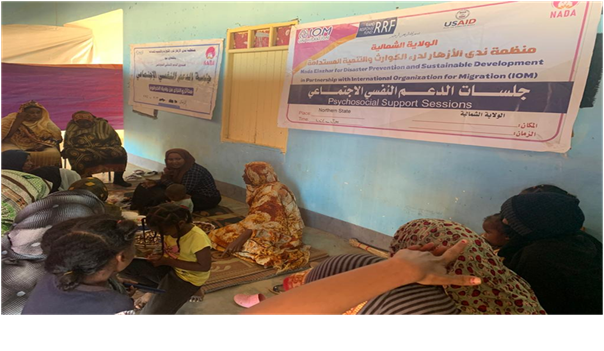- Nada Elazhar
- Nada Elazhar for Disaster Prevention and Sustainable Development (NADA)
- +249123228852


NADA
is a humanitarian national NGO and women-led organization that specializes in
front-line emergency protection services. SHF has proven to be a reliable
funding resource for us, as it funded over the last decade a quarter of our
grants. It’s been the best source of funding for quick emergency response to
newly emerging needs, and for funding for hard-to-reach areas.
Over
the next six minutes, I will explain
-
how NADA is addressing
disability in its programming,
-
the main challenge we see
for disability prioritization
- and the efforts to be made to overcome this challenge.
Over
the last decade,NADA has reached 2 million beneficiaries. Around 10 per cent of
them have been persons with disabilities.
We
reach them through inclusive programming and sometimesthrough specific
services. NADA identifies people with disabilities as a specific target
group, values their participation in our programme cycle management
and in our operations and removes barriers, such as social stigma, so
they are not excluded from our services. We believe that prevention
should be our main goal, and disability-specific advocacy a never-ending
exercise.
NADA
assures that persons with disabilities are engaged in all stages of the
project cycle.
o They
are specifically targeted as a group in our needs assessments, so their
needs and concerns are well reflected in our projects.
o Also,
our monitoring and evaluation activities consider them as a specific
group, so we can learn how to do better.
We
assure our persons with disabilities stay informed.
o For
example, our teams use silent theatre for awareness raising
interventions.
o
Mobile public campaigns
are an excellent way to reach persons with physical disabilities and blind
people with services.
o
Through awareness
raising sessions, we assure that persons with disabilities are aware of
their rights.
o Also,
we always assure that persons with disabilities are represented in our
community-based protection networks.
Prevention is
also at the core of our work.
o For
example, immediatelyafter the conflict erupted in Darfur in May 2023, NADA
reprogrammed its SHF projects in Darfur so toaccommodate lifesaving protection activities.
Indeed, protection is essential as part of the immediate response,such as Explosive
Ordnance Risk Education.
o
We are especially proud of
our activities that combine inclusiveness with prevention. For example,
our programme in Central Darfur recruited Explosive Ordonnance victims to
deliver the EORE sessions to their communities. This inclusive approach not
only avoids more people to become disabled but also helps to avoid social exclusion
of these people.
o Timely dissemination of such messages saves the lives of thousands of people in remote areas.
While NADA also includes specific disability-services, such as provision of mobility aids and assistive devices, what I am trying to convey here is that a disability-focused approach is much more than providing disability services. Integrating a disability-focused approach throughout the project does not cost money – on the contrary, it makes our projects more cost-effective, and should therefore be the baseline for all projects.
The ultimate goal should always be prevention. Quick access to fundingwithin weeks, combined with a flexible approach by a donor that values the knowledge of the people operating in the field, is instrumental. The SHF has shown to be an excellent partner in that sense.
As
a women-led NNGO, I want to give special attention to our work around
GBV, and the challenges related to disability.
o NADA
assures that women and girls with disabilities are specifically targeted in
our GBV work. These women and girls are especially vulnerable due to the
social stigma that rests upon them and their social isolation. We assure their
voices are heard, and their rights are protected.
o For
example, in Northern State, two months into the crisis, SHF funded a
community-based GBV programme in a society that did not recognize GBV as a
critical issue. Initial resistance transitioned into increased awareness on
women rights and GBV issues, contributing to social cohesion and
transformation. GBV survivors including women with disabilities, both in the
host community and IDPs, now have access to GBV services.
o In
the same state, through SHF’srapid response funding, also known as the 48 hours’modality,
SGBV survivors saw theirperpetrators judged with a 20 year prison sentence.This
not only contributes to justice, but also to prevention. We continue the
support for two survivors, whom due to their disabilities, have difficulties to
have their testimonies accepted by the Sudanese laws.
o Therefore,
we continue to include disability-specific messages in our advocacy work.
Last month, NADA, among other advocators,launched a national campaign which
call foran end torape and sexual exploitation for women and girls in Sudan.During
the widely attended event, a strong presentation was delivered on behalf of
women with disabilities whom are victims of trafficking and alarming number of
them faced rape and sexual exploitation and abuse in remote and hard to reach
areas. It is important to mention this national campaign was built on data
collected during our ongoing SHF project in Northern State.
And
finally, as a national NGO, I would like to take pause on the
consideration that persons with disabilities are often hidden in society, they
are stigmatized, many barriers exist or are actively raised. A thorough
understanding of the local society and awareness of these challenges by senior
management in an NGO is essential.
Clearly,
I’m advocating to strongly consider national actors as potentially the best
champions for a disability response.
So, having that said, what do we see as the main challenge?
The situation in
Sudan is disastrous. Last year, when the war broke out in Sudan, Sudan
received as much humanitarian funding as the year before, while, stating the
obvious, the humanitarian needs had exploded.
We expect this year even less humanitarian funding as in the previous years, while a catastrophic food crisis is waiting for us in a few months in a context of continued warfare.
How to reconcile a disability focus, often snowed under by other priorities such asPSEA, Gender, centrality of protection, localization, AAP, etcetera, with the humanitarian core business to keep people alive? How to reconcile increasing demand for quality programming with decreasing funding?
Or, how to do more with less?
As I explained today,
this is possible.
We understand that it is difficult to have dedicated funds for disability programs, considering the extreme humanitarian needs and disappointing funding levels in Sudan.
But, this cannot be an excuse not to consider the needs of the most vulnerable among the vulnerable.Donors and implementing partners should be held accountable.
- in terms of NGO’s holding themselves
and their staff accountable:
o As
an absolute minimum, we must ensure that disability is better integrated in the
humanitarian response. We must ensure that,in every step of the project,
someone in the NGO thinks of what it means for a person with a disability. The
NGO should, if needed, respond accordingly, even if this means to adapt its
activities.
o This
requires donor flexibility.
o It
requires project implementation policies integrating disability throughout the
project life-cycle.
o It
also requires staff being properly trained.
Such
training should be available in country, ideally provided by a UN Agency. Such
agency should also assure that data-collection and an understanding of the
disability context in a country is available.
- But also donors should hold the
NGO’s they fund accountable. Project monitoring and evaluations should include
a disability focus.
Is this a standard question in your monitoring report templates?
- And
finally, donors must be held accountable.
o Protection programming should be continued to be valued as an urgent life-saving response, and should therefore continued to be funded as a priority.
o Really, this is not just the soft-ish protection lingo we are all getting used to. I mean this. It – Is – Lifesaving! And, it is preventing worse!
o Therefore, donors should continue to fund protection response. It remains the best way to reach persons with disabilities.
o And, the best way to assure protection remains funded, is to assure that the overall humanitarian funding for a country fluctuates with the level of humanitarian needs. When this is not the case, like in Sudan, protection is at risk of being pushed away by clusters that are perceived as being more lifesaving.
o Here,
I want to refer again to the SHF. Over the last years, SHF has allocated around
25 per cent of its funding to dedicated protection activities, most of the time
as part of an area-based multi-cluster programme. It has done this so by
including this as a specific allocation target. That is what we consider a good
donor!
----- PAUSE TWO SECONDS ----
So,
in conclusion:
- Let’s
integrate disability in our programming, through protection funding, through
inclusive programming and implementation, through project cycle management,
through monitoring, through training and awareness raising.
- Let’s
make sure persons with disabilities are specifically targeted, by assuring they
are informed, their community is aware of their challenges and the project is
aware of barriers to their services. Let’s continue to advocate for their
rights, try to include disability specific activities, and let’s try to prevent
worse.
- Let’s continue to make staff, NGOs and Agencies and donors and funds accountable for their work.
- And finally, let’s value the potential the country-based pooled funds offer in this respect. In Sudan, the Humanitarian Fund has proven to be an incredible ally in our work, by being quick, supportive and respectful towards our know-how, by prioritizing protection funding and funding to national NGOs.